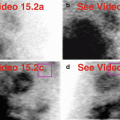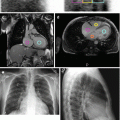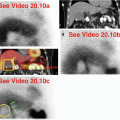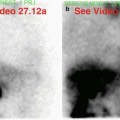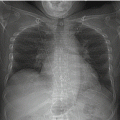and Vincent L. Sorrell2
(1)
Division of Nuclear Medicine and Molecular Imaging Department of Radiology, University of Kentucky, Lexington, Kentucky, USA
(2)
Division of Cardiovascular Medicine Department of Internal Medicine Gill Heart Institute, University of Kentucky, Lexington, Kentucky, USA
Electronic supplementary material
The online version of this chapter (doi: 10.1007/978-3-319-25436-4_3) contains supplementary material, which is available to authorized users.
The first step in image interpretation is careful review of the rest raw and stress raw planar projection data sets in a cinematic format, ideally side-by-side (Gholamrezanezhad and Mirpour 2007; Hendel et al. 1999; Holly et al. 2010; Strauss et al. 2008). As outlined in Table 3.1, one should routinely and systematically assess the quality of each acquisition for patient motion, positioning in the detectors’ field-of-view, sources of soft-tissue attenuation, and technical performance of the gamma camera system. Despite close attention given to consistent positioning, breast tissue can shift between image acquisitions and can create artifactual findings on the reconstructed SPECT images (Holly et al. 2010). Such variable soft-tissue attenuation (breasts, obesity) may result in variable stress and rest defects that can lead to misinterpretation of reversibility (i.e., ischemia).
Table 3.1
Structured approach to evaluation of SPECT MPI raw projection data
Step-by-step approach to interpretation | |||
|---|---|---|---|
Step | Domain | General checklist | Specific observations |
1 | Quality of acquisition | Patient motion | Horizontal vs. vertical or both |
Positioning within field-of-view | Centered vs. off-center | ||
Soft-tissue attenuation | Regional body fat or muscle, breasts, diaphragm | ||
Technical performance | Excess vs. loss of counts, mechanical failure | ||
2 | Heart | Left ventricle | Axis and orientation |
Chamber size and shape | |||
Myocardial uptake pattern (uniformity, defects) | |||
Right ventricle | Chamber size and shape | ||
Myocardial uptake pattern (intensity, thickness) | |||
3 | Chest | Biodistribution pattern | Normal structures/tissues |
Abnormal findings (“hot” or “cold”) | |||
4 | Abdomen | Biodistribution pattern | Normal structures/tissues |
Abnormal findings (“hot” or “cold”) | |||
The next steps in image interpretation are identification and description of the cardiac and noncardiac findings, followed by interpretation of their etiology and significance. The raw data allow for an initial evaluation of the heart: the left ventricular axis and orientation, size and uptake pattern, the right ventricular size and degree of uptake, and recognition of the frequently prominent right auricular appendage (refer to Chap. 13).
A representative normal 1-day rest/stress gated SPECT MPI is shown in Fig. 3.1. The heart is positioned in the middle of the field-of-view on the rest raw (a) and stress raw (b) projection images, and there is only quiet respiratory motion during the approximately 15-minute acquisition. Note the normal right auricular appendage (c), the commonly seen minimal gastric activity (e), and normally visualized liver (a, b), gallbladder (d), small intestine (a, b), and left kidney (f). The processed SPECT images (g, h) show a uniform myocardial uptake pattern without reversible or fixed perfusion defects. On the gated SPECT images (i, j), there is normal global left ventricular systolic function with a normal left ventricular ejection fraction, normal regional wall motion evidenced by appropriate excursion during the cardiac cycle, and normal wall thickening evidenced by brightening of the color within the myocardial walls during systole. With experience, the subsequent SPECT MPI reconstructions can, and should, be predicted with a high degree of confidence and consistency.






Fig. 3.1
Typical normal 1-day rest/stress gated SPECT MPI. This patient exercised well on a treadmill. Left ventricular ejection fraction was 73 %. The rest raw (a) and stress raw (b) images were acquired on a standard field-of-view gamma camera. Anatomic landmarks are identified (c–f). The processed SPECT (g, h) and gated SPECT (i, j) images are normal.(a) Rest raw projection image (Video 3.1a, frame 1), 99mTc sestamibi. (b) Stress raw projection image (Video 3.1b, frame 1), 99mTc sestamibi. (c) Stress raw projection image (Video 3.1c, frame 13), 99mTc sestamibi, right auricular appendage (yellow box). (d) Stress raw projection image (Video 3.1c, frame 29), 99mTc sestamibi, gallbladder (blue lines). (e) Stress raw projection image (Video 3.1c, frame 43), 99mTc sestamibi, stomach (blue oval). (f) Stress raw projection image (Video 3.1c, frame 57), 99mTc sestamibi, left kidney (blue lines). (g) Stress (top row A)/rest (bottom row B) processed SPECT images (from left to right: SA short-axis from apex to base, VLA vertical long-axis from septum to lateral wall, HLA horizontal long-axis from inferior wall to anterior wall), myocardial walls labeled in schematics along right margin of image (Note: The conventional orientation and display are used throughout this book.) (h) Stress (top row A)/rest (bottom row B) processed SPECT images (SA short-axis, VLA vertical long-axis, HLA horizontal long-axis), stomach (blue ovals), right ventricle (yellow box). (i) Stress gated SPECT image (Video 3.1d, frame 1) (SA, VLA, HLA). (j) Stress gated SPECT image (Video 3.1e, frame 1) (SA, VLA, HLA), stomach (blue ovals), membranous septum (yellow box)
One should also be able to recognize normal tissues and variants, including the thyroid gland, skeleton (faint), skeletal muscle, and brown adipose tissue (Chamarthy and Travin 2010; Henzlova et al. 2009; Holly et al. 2010; Mohr et al. 1996; Wackers et al. 1989). Figure 3.2 shows normal skeletal muscle about the left shoulder and upper chest wall. Patients are routinely imaged with both arms raised alongside their head to permit positioning of the gamma camera detectors as close as possible to their chest. The shoulder musculature can be more prominent, especially after a high exercise workload (because the patient’s arms grip the handrails while walking on the treadmill) and could be misleading to the inexperienced.


Fig. 3.2
Normal skeletal muscle in chest wall, shoulders, and back. This patient exercised on a treadmill for 6 minutes to 87 % of the maximal predicted heart rate and achieved 11.5 METS (metabolic equivalents). This stress SPECT MPI (a–c) acquired with his arms raised alongside his head shows normal shoulder musculature.(a) Stress raw projection images (Video 3.2a, frame 1), 99mTc sestamibi. (b) Stress raw projection image (Video 3.2b, frame 1), 99mTc sestamibi, right shoulder musculature (blue box). (c) Stress raw projection image (Video 3.2b, frame 46), 99mTc sestamibi, left shoulder musculature (blue box)
Regardless of the radiopharmaceutical, one should consistently inspect the SPECT MPI raw projection data for incidental extracardiac findings that can signal underlying pathology (including unsuspected neoplasms), be physiologic, or be artifactual in nature. Incidental findings have been reported in up to 6 % of patients undergoing MPI (Chamarthy and Travin 2010; Gedik et al. 2007; Gentili et al. 1994; Gholamrezanezhad et al. 2006; Hendel et al. 1999; Howarth et al. 1996; Raza et al. 2005a, b; Shih et al. 2002, 2005; Williams et al. 2003). Such incidental findings can be expected (i.e., related to known clinical conditions) or unexpected and can be significant enough to warrant communication to the referring physician. Sources of “hot” artifacts (such as radiopharmaceutical or radioactive urine contamination, liver activity, and/or stomach activity) and “cold” artifacts (such as metallic objects, breast tissue, fluid collections, left hemidiaphragm) may have significant bearing on the accurate interpretation of cardiac findings (Burrell and MacDonald 2006; Chamarthy and Travin 2010; Holly et al. 2010). Correlation with medical and surgical history and other imaging may be required for optimal interpretation and is beneficial for quality assurance in clinical practice (and especially valuable for teaching students, residents, and fellows in training).
There are many potential pathologies and imaging artifacts related to the organ systems that lie within the SPECT MPI field-of-view. Tables 3.2 and 3.3 classify these imaging findings as “hot” or “cold” and organize them by location: “above the diaphragm” in the chest and “below the diaphragm” in the abdomen. Italicized text items may warrant personal communication to the primary or referring physician. The written report should contain language along the lines of the following example:
Table 3.2
Differential diagnosis of “hot” and “cold” imaging findings in the chest
“Above the Diaphragm” | |||
|---|---|---|---|
Organ system | “Hot” finding | “Cold” finding | References |
Thyroid gland | Multinodular goiter Diffuse toxic goiter Substernal goiter Nodule/neoplasm, benign Nodule/neoplasm, malignant Lymphoma Free 99mTc pertechnetate | Cyst Neoplasm, primary Neoplasm, metastasis | Chamarthy and Travin (2010) Gedik et al. (2007) Seabold et al. (1999) Seo et al. (2005) Smith and Oates (2004a) Sundram and Mack (1995) Williams et al. (2003) |
Parathyroid glands | Adenoma Hyperplasia Carcinoma | Cystic adenoma | Chamarthy and Travin (2010) Coakley et al. (1989) Gedik et al. (2007) Lazar et al. (2005) O’Doherty et al. (1992) Smith and Oates (2004b) |
Breasts | Cystic disease Fibroadenoma Microcalcifications Hematoma Scar Lactation Gynecomastia (periareolar pattern) Carcinoma | Cyst Implants Prosthesis Soft tissue/shifting breasts (positional) Mastectomy | Arbab et al. (1995) Burrell and MacDonald (2006) Chamarthy and Travin (2010) García-Talavera et al. (2013) Gedik et al. (2007) Hendel et al. (1999) Hesse et al. (2005) Holly et al. (2010) Howarth et al. (1996) Mlikotic and Mishkin (2000) Ramakrishna and Miller (2004) Shih et al. (2002) Waxman (1997) Williams et al. (2003) |
Chest wall | Brown adipose tissue Shoulder/upper chest skeletal musculature (due to arterial injection) Contamination (radiopharmaceutical, urine) Cross talk from nearby radioactive source (another patient on treadmill) | Soft-tissue mass Internal metal objects (pacemaker, defibrillator, vascular port) External metal objects (jewelry, chain, coin, keys, belt buckle) Arms by sides (positioning) Cracked crystal Malfunctioning photomultiplier tube | Afzelius and Henriksen (2008) Burrell and MacDonald (2006) Chamarthy and Travin (2010) Gedik et al. (2007) Gentili et al. (1994) Goetze et al. (2008) Hendel et al. (1999) Howarth et al. (1996) Vijayakumar et al. (2005) Williams et al. (2003) |
Skeleton | Anemia/thalassemia Fracture/sternotomy Osteomyelitis Gaucher disease Paget disease Myelofibrosis/myelodysplastic process Multiple myeloma Osteosarcoma/sarcoma Neoplasm, metastasis | Neoplasm, metastasis | Caner et al. (1992) Chamarthy and Travin (2010) Fisher et al. (2000) Gowda et al. (2006) Mariani et al. (2003) Maurea et al. (1995) Mohr et al. (1996) Onsel et al. (1996) Shih et al. (2005) Soderlund et al. (1997) Williams et al. (2003) |
Pleura | Neoplasm, malignant/mesothelioma Pleural effusion, malignant | Pleural effusion, benign Pleural effusion, malignant | Chamarthy and Travin (2010) Chin et al. (1995) Eftekhari and Gholamrezanezhad (2006) Gedik et al. (2007) Joy et al. (2007) Shih et al. (2002) Williams et al. (2003) |
Lungs | Congestive heart failure (diffuse pattern) Interstitial lung disease Smoking Atelectasis Hematoma Pneumonia Fibrosing alveolitis Actinomycosis Granulomatous disease (sarcoidosis/tuberculosis) Neoplasm, primary malignant (lung carcinoma, carcinoid) Neoplasm, metastasis Lymphangitic carcinomatosis | Hyperinflation/emphysema Pneumonectomy/elevated right hemidiaphragm Elevated left hemidiaphragm | Aras et al. (2003) Bom et al. (1998) Chamarthy and Travin (2010) Chin et al. (1995) Eftekhari and Gholamrezanezhad (2006) Gedik et al. (2007) Hendel et al. (1999) Mohr et al. (1996) Nishiyama et al. (1997) Onsel et al. (1996) Reyhan et al. 2004) Seo et al. (2005) Shih et al. (2002) Takekawa et al. (1999) |
Mediastinum | Gastroesophageal reflux Hiatal hernia (refluxed duodenogastric bile) Neoplasm, primary malignant (esophageal cancer, thymoma) Extramedullary hematopoiesis (paravertebral masses) | Cyst Dilated esophagus Fluid- or food-filled hiatal hernia | Bhambhvani et al. (2010a) Burrell and MacDonald (2006) Chadika et al. (2005) Chamarthy and Travin (2010) García-Talavera et al. (2013) Gedik et al. (2007) Hawkins et al. (2007) Niederkohr et al. (2009) Raza et al. (2005c) Seo et al. (2005)
Stay updated, free articles. Join our Telegram channel
Full access? Get Clinical Tree
 Get Clinical Tree app for offline access
Get Clinical Tree app for offline access

|

